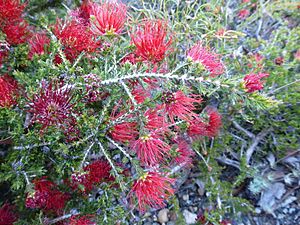Stirling Range bottlebrush facts for kids
Quick facts for kids Stirling Range bottlebrush |
|
|---|---|
 |
|
| Beaufortia cyrtodonta growing near the Bluff Knoll walking track. | |
| Scientific classification | |
| Genus: |
Beaufortia (plant)
|
| Species: |
cyrtodonta
|
| Synonyms | |
|
|
The Stirling Range bottlebrush, also known as Beaufortia cyrtodonta, is a special plant found only in the southwestern part of Western Australia. It belongs to the myrtle family, called Myrtaceae. This plant is a small, bushy shrub with lots of leaves that look a bit grey because they are covered in tiny, soft hairs. In spring, it grows beautiful red flowers that look like little brushes. You can find it growing in the Stirling Range area.
Contents
What the Stirling Range Bottlebrush Looks Like
The Stirling Range bottlebrush is a small, compact shrub. It usually grows up to about 1.5 meters (5 feet) tall. Its leaves are long and narrow, and they grow very close together. They are arranged in a special way, in opposite pairs that cross each other. This makes them look like they are in four neat rows along the stems.
The leaves are about 4 to 7 millimeters long. They often have tiny, soft hairs on them, which makes the plant look a bit grey.
Flowers and Fruits
The flowers of the Stirling Range bottlebrush are bright red. They grow in round clusters at the ends of the branches. Each cluster is about 2.5 centimeters (1 inch) across.
Each flower has 5 sepals (small leaf-like parts at the base), 5 petals, and 5 groups of stamens. Stamens are the parts of the flower that produce pollen. Each group has 3 stamens joined together. These joined parts are about 8.5 to 13.5 millimeters long. The free ends of the stamens are another 1.5 to 3 millimeters long.
This plant flowers from June to November. After the flowers, it produces woody fruits called capsules. These capsules are 7 to 13 millimeters long and grow in tight clusters.
How it Got its Name
The scientific name for this plant, Melaleuca cyrtodonta, was first written down in 1847 by a scientist named Nikolai Turczaninow. Later, in 1867, another scientist named George Bentham moved it to the Beaufortia group. That's how it got its current name, Beaufortia cyrtodonta.
The second part of its name, "cyrtodonta," comes from two old Ancient Greek words. "Kyrtos" means "curved" or "bent," and "odous" means "tooth."
Where the Plant Lives
The Stirling Range bottlebrush mostly grows in the Stirling Range area of Western Australia. This includes several different natural regions like the Avon Wheatbelt, Esperance Plains, Jarrah Forest, and Mallee. It likes to grow in sandy or gravelly soils. These soils often come from a type of rock called laterite found on hills and rocky areas.
Is it Endangered?
The Western Australian Government's Department of Parks and Wildlife has looked at the Stirling Range bottlebrush. They have classified it as "not threatened." This means that there are enough of these plants in the wild, and they are not currently at risk of disappearing.
Images for kids



